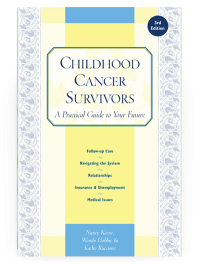Childhood Cancer Survivors
Ewing sarcoma
Ewing sarcoma gets its name from the physician who first described it in 1921, Dr. James Ewing. For many years it was believed that Ewing sarcoma occurred only in the bone; however, other tumors within soft tissues have since been found to be similar. These include extraosseous Ewing sarcoma (EES) and peripheral primitive neuroectodermal tumor (PNET). Together, these malignancies are called the Ewing sarcoma family of tumors (ESFT).
Each year in the United States, about 500 children and adolescents younger than age 20 are diagnosed with an ESFT malignancy. The majority are diagnosed with Ewing sarcoma of the bone.
ESFT tumors can occur from ages 5 to 10, but the incidence rate sharply increases at age 11. The peak incidence occurs at age 15. Boys tend to be diagnosed with this disease more often than girls, and there is a much higher incidence in white children than children of other races.
The treatment and late effects are similar for both types of tumors and are addressed together in this section.
Treatment
ESFT tumors usually require surgery, radiation, and chemotherapy.
Surgery
Before the development of limb-salvage surgery and newer radiation techniques, most children with extremity tumors had the affected limb amputated. Many children now are treated with state-of-the-art radiation therapy and/or have limb-salvage procedures that use autologous grafts, allografts, or endoprostheses. In some cases, orthopedic reconstruction is required after removal of the tumor.
Radiation
Radiation is needed to treat children diagnosed with ESFT tumors that cannot be completely removed. Some chest wall tumors are treated with whole-lung radiation. ESFT tumors are generally treated with doses ranging from 4000 to 5600 cGy, fractioned over a period of 4 to 6 weeks.
In the past, cranial radiation was used to prevent central nervous system (CNS) relapses in patients with Ewing sarcoma. Since then, studies have shown this is unnecessary for patients who have no tumor in the bones of the skull. Whole-lung radiation also was used in some studies to reduce the number of pulmonary relapses; however, this resulted in significant toxicity when combined with systemic chemotherapy. Currently, lung radiation is used only for some chest wall tumors.
Chemotherapy
Before chemotherapy became a standard weapon against ESFT tumors in the 1960s, very few children survived. Chemotherapy improved the long-term survival rate and made it easier to remove the tumor by making it smaller before surgery. Treatment of Ewing sarcoma now includes chemotherapy for all children. This is necessary even for children with localized disease. The most commonly used combinations of chemotherapy drugs include vincristine (Oncovin ® ), doxorubicin (Adriamycin ® ), cyclophosphamide (Cytoxan ® ), ifosfamide (Ifex ® ), and etoposide (VP-16 or Vepesid ® ).
Late effects
This section briefly outlines some common and uncommon late effects from treatment. Remember that you may develop none, one, or several of these problems in the months or years after treatment ends.
Damage to soft tissues and bones. One of the most common and troublesome late effects from radiation treatment for ESFT tumors is damage to soft tissues and the underlying bones. If the leg of a young child gets high doses of radiation, it stops growing and will be shorter than the unirradiated leg. Radiation around the arm or leg can result in fibrosis (meaning scarring), swelling, and poor function. Most of these changes happened with older radiation techniques.
Currently, many patients are given up to 5000 cGy using shaped fields to help protect normal appearance and function. Loss of function can also be minimized or prevented by a comprehensive physical therapy program during and after treatment. For more information, see Chapter 17 .
Heart problems. Heart problems can occur months or years after treatment with anthracyclines (i.e., doxorubicin, idarubicin, or daunorubicin), high-dose cyclophosphamide, or chest radiation. Symptoms include shortness of breath, fatigue, wheezing, anxiety, poor exercise tolerance, rapid heartbeat, and irregular heartbeat. The number of ESFT tumor survivors who develop this late effect is small, but regular checkups are crucial. Survivors often have no symptoms, but problems may be found on cardiac tests such as echocardiograms, electrocardiograms (EKGs), and Holter monitors. For more information, see Chapter 12 .
Hepatitis C. Infection with the hepatitis C virus can develop in survivors who had blood transfusions prior to July 1992. For more information, see Chapter 15 .
Fertility. Abdominal radiation and high doses of cyclophosphamide and/or ifosfamide can affect fertility. For more information, see Chapter 9 and Chapter 3 .
Digestion. Abdominal radiation can also cause problems with digestion and absorption of food. For more information, see Chapter 15 .
Second cancers. There is a very small chance of developing a second cancer in the radiated area. For more information, see Chapter 19 .
Table of Contents
All Guides- 1. Survivorship
- 2. Emotions
- 3. Relationships
- 4. Navigating the System
- 5. Staying Healthy
- 6. Diseases
- 7. Fatigue
- 8. Brain and Nerves
- 9. Hormone-Producing Glands
- 10. Eyes and Ears
- 11. Head and Neck
- 12. Heart and Blood Vessels
- 13. Lungs
- 14. Kidneys, Bladder, and Genitals
- 15. Liver, Stomach, and Intestines
- 16. Immune System
- 17. Muscles and Bones
- 18. Skin, Breasts, and Hair
- 19. Second Cancers
- 20. Homage
- Appendix A. Survivor Sketches
- Appendix B. Resources
- Appendix C. References
- Appendix D. About the Authors
- Appendix E. Childhood Cancer Guides (TM)

